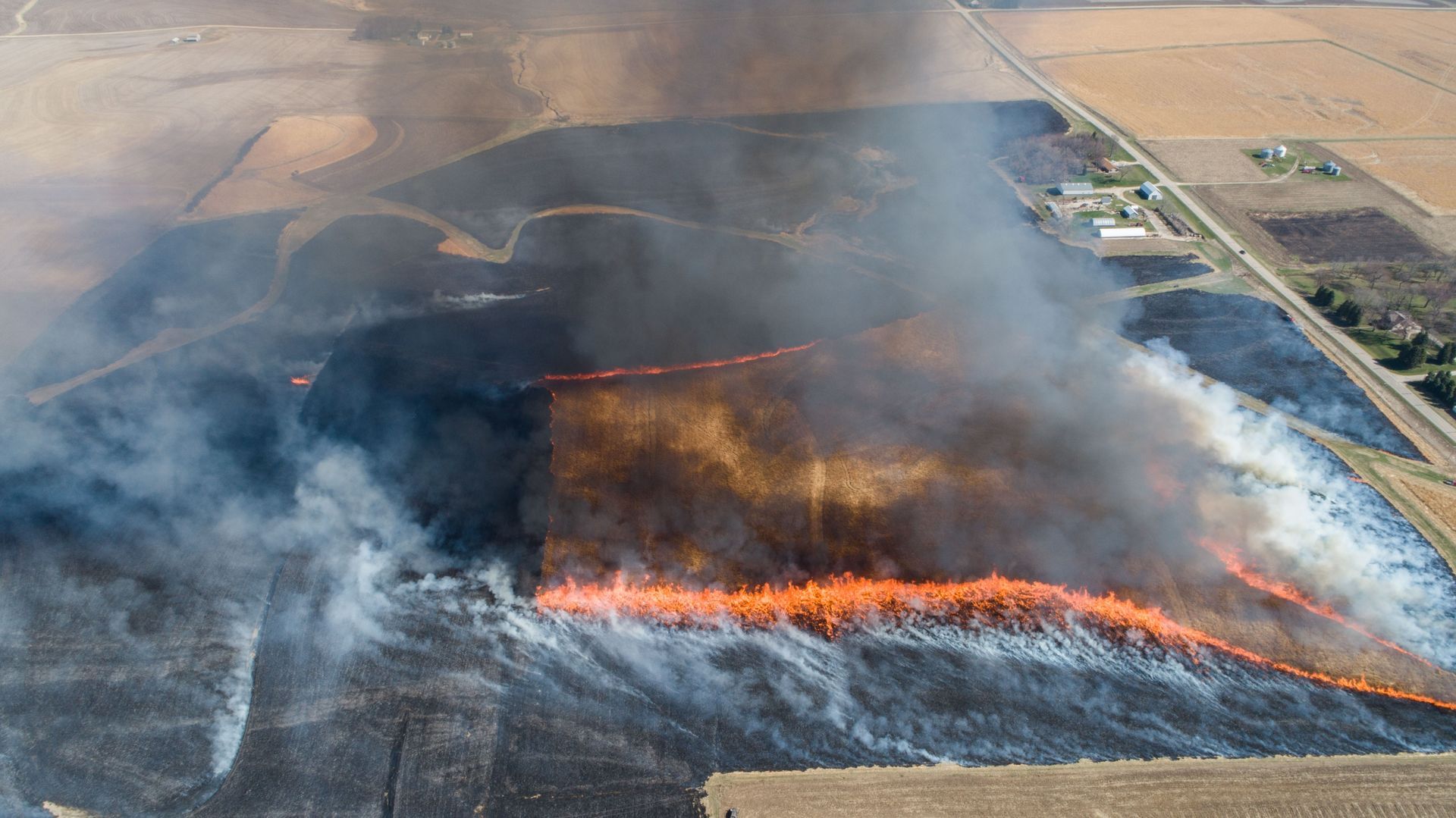2024 TOP 10 BLOG
Natural, Native Solutions to Fire
VJEL Staff Editor: Joseph Gerngross
Faculty Member: Mark James
“[W]hy don’t you fight the rain, or fight earthquakes?”
– Chook Chook Hillman, Natural Resources Technician, Karuk Department of Natural Resources
Wildfires pose a risk to human life and property in a way that was far less common in pre-Columbian North America, in large part due to the absence of a regular cycle of controlled burns by indigenous cultures that mitigated wildfires. Indeed, as part of deliberate fire policies set forth by state and federal governments, large amounts of highly flammable natural fuel have accumulated on the floors of western forests over the past two centuries. Now, governments spend billions on fire suppression, fighting a natural force that always had a dominant role in the ecology of the American West. Recently, the United States Forest Service (USFS) recently announced a goal of 50 million acres of prescribed burns.
The resources devoted to the armies of firefighters employed to suppress the natural process of burning and regrowth should instead be invested in armies of fire-starters. Indigenous American communities had intimate knowledge of the impact of, and necessity for, periodic fires to renew the land. For thousands of years, indigenous communities native to North America practiced controlled burns to protect their forests, promote healthy growth, and, knowingly or not, protect themselves from the type of devastating wildfires that currently plague the American West. Today, indigenous communities are using their histories and traditions to educate the more receptive American community about the delicate practice of controlled burns.
Forgotten Knowledge
Figure 1: The Nature Conservancy: Quiet Fire (2020)
In California and Oregon, the Karuk, the Yarok, and Hoopa tribes had for countless generations practiced periodic burns to restore foraging resources and attract herbivorous animals to regrowing vegetation. To varying degrees, keeping in mind the recent frequency of naturally-started fires, indigenous people periodically burned their land for the benefit of themselves and the ecosystem. In a unique way, indigenous North Americans became part of the ecology of the land, another tile in the mosaic of biodiversity they relied upon.
So, human beings represented a keystone species in pre-Columbian environments in North America, promoting biodiversity and creating niches that otherwise would not exist. But these burn practices had a different, more widespread effect on the landscape itself. Land managed by prescribed fires was punctuated by open prairies and savannahs with sparse stands of trees. The landscape of inland North pre-settlement America looked very different than it does today, and ecosystems were far more resistant to wildfires due to the reduced fuel conditions and lower biomatter density that indigenous burning practices created. Periodic cleansing of the undergrowth not only opened up the land to new growth but reduced the risk of catastrophic fires by exhausting natural fuels periodically. Some settlers described the bleak, blackened expanses of prairies that indigenous peoples created with their prescribed burns. From their Western perspective, this savage, destructive practice of prairie burning was abhorrent to their concept of property ownership that formed the locus of European life. They never made the connection that the abundance of the Americas was in managed environments, gardenesque lands created deliberately by indigenous tribes for their communal use and for the health of their environment.
The deliberate destruction of indigenous cultures by white settler governments scattered the accumulated cultural knowledge of hundreds of generations of indigenous land stewardship. White settlers and the United States Army brutalized and evicted indigenous tribes in a long-term, systematic, ethnic cleansing that obliterated many indigenous North American cultures. With their demise, the world lost the wisdom and expertise of fire that indigenous peoples had perfected over millennia.
Accepting Fire and Restoring Tradition
In recent years, some tribes have revived their ancient burning practices, sharing their knowledge of the forest with governments and landowners alike. The Karuk tribe has lived on the Klamath River for countless generations, and, in the pre-settlement era, employed controlled burning to restore their land and reduce fuel loads. The Karuk work in tandem with the Klamath Prescribed Fire Training Exchange (KTREX) to expose the wider conservation field to their cultural knowledge of prescribed fire practices. “These forests are just tinderboxes waiting to go, and we have to have [prescribed] fire on the landscape to stop the catastrophic fire from destroying the landscape,” said Chook Chook Hillman, a Natural Resources Technician in the Karuk Department of Natural Resources. “If we don’t get [society] to accept fire, we’ll just keep losing these huge swaths of forest.”
From the perspective of the tribal community, the stakes are even higher. While Western culture increasingly adopts indigenous burning practices for the preservation of private property, timberlands, and cropland, tribes like the Karuk are attempting to regain the very fundaments of their culture. For many tribes like the Karuk, their regalia, food, medicine, and other culturally significant products and practices rely on species that have faded away since the disappearance of prescribed fire. The survival of the Karuk culture itself depends heavily on fire. Hillman laments, “How do I continue being myself if I don’t have these things? Whether it’s salmon, a forest, how do I live? Maybe I’m still alive, but would you want to be if your landscape is completely gone?”
A closely related tribe, the Yarok tribe, has partnered with the California Department of Forestry and Fire Protection (CAL FIRE) to experiment with small burns on their tribal land. Much of the impetus for this collaboration has been the desire of tribes like the Yarok to regrow certain plants, common before the era of fire suppression, which are vital to the practice of their ancient traditions. Prescribed burns have been incredibly successful to this end. In 2013, the tribe-government collaboration successfully employed the ancient practice of prescribed burning using modern controlled-burn equipment and protective gear. As the fire burnt across the Karuk’s ancestral forests, the marching flame left the ground black with ash. Tongues of flame reached up and scorched the bottom few inches of the larger woody plants. That area of forest was successfully relieved of its accumulated natural fuels, but, more importantly, after several weeks, the forest floor was blanketed by clean, straight hazelnut stalks from which the Yarok weave their traditional baskets.
After the hazel plants sprang up from the forest floor, their long stems were harvested by the Yurok community for the elaborate baskets that carry their babies, their food, and part of their culture. Yarok mothers could finally weave their baby baskets for the first time in years. Elizabeth Azzuz, Yurok tribal member and Head of Logistics of the Cultural Fire Management Council (CFMC), attending a recent burning, commented on the cultural revival that prescribed burns facilitate. “Everything that comes up new is going to make a basket weaver’s dream come true,” said Azzuz. The introduction of tribally managed fires also brings back prairie grains and wild potatoes that have been sparse in these lands for decades. “[W]e’re reclaiming our food security,” said Margo Robbins, President of CMFC.
Waking Up the Government with TEK
Some government efforts in more recent years seem to signal a sea-change in the world of fire management, especially after fires like the deadly Camp Fire in Northern California that caused at least 85 fatalities and represented the costliest global disaster in 2018. As a result of the Camp Fire and fires like it, the nation seems to be waking up to the traditions of prescribed fire. “[G]overnment agencies…are starting to realize that native people know more than a little something about what the land needs and how to use fire,” says Margo Robbins. The National Park Service (NPS) in partnership with the Bureau of Indian Affairs (BIA) is making concerted efforts to use traditional ecological knowledge (TEK) to apply fire to land in need of renewal and fuel reduction.
The ecological health and fire safety of the American West requires prescribed fire. The adoption of TEK by government agencies is a major change in federal and state fire regimes. The NPS and the BIA are navigating the bureaucratic and practical channels that a cooperative fire regime based on TEK requires. The USFS embraces and assists in prescribed burns on tribal land, and uses prescribed burns on the land it manages. The USFS’s goal of 50 million acres for prescribed burns makes implementing TEK-based fire practices critical to achieving this goal. However, the widespread use of TEK-based fire regimes in land controlled by the USFS remains to be seen. These continuing efforts will inspire other federal land management agencies to use prescribed burns on their land and employ TEK in their wider practices. Cooperation between governmental entities on the West Coast, both federal and state, with indigenous tribes like the Karuk will revitalize forest ecology, create a safer fire regime for the American people, and nurture a more vibrant cultural landscape for indigenous tribes whose traditions rely on periodic fire.








